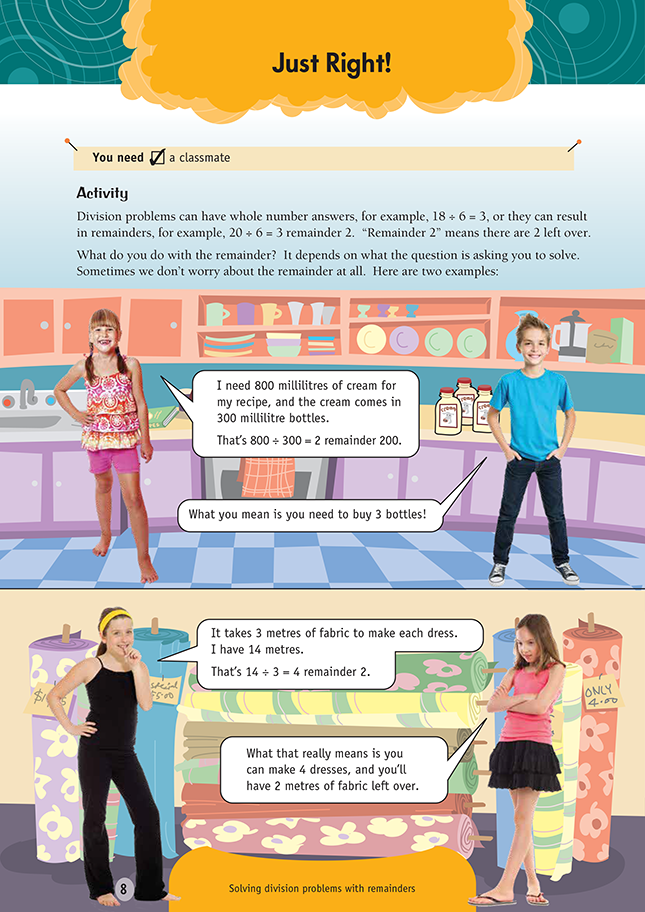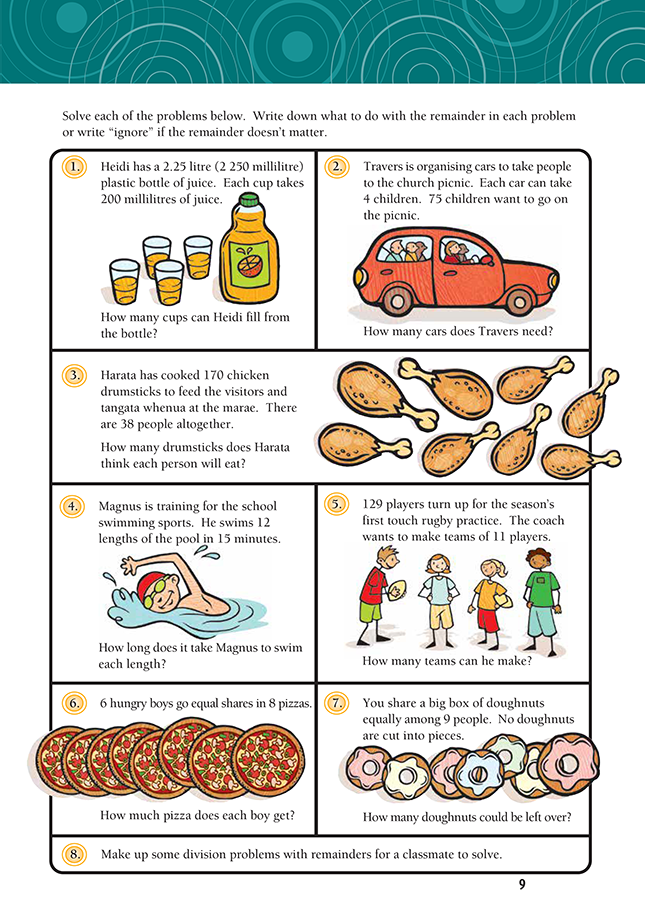This is a level 4 number activity from the Figure It Out series. It relates to Stage 7 of the Number Framework.
A PDF of the student activity is included.
Click on the image to enlarge it. Click again to close. Download PDF (490 KB)
solve division problems with remainders
Number Framework Links
Use this activity:
• to encourage transition from advanced additive strategies (stage 6) to advanced multiplicative strategies (stage 7)
• to help your students extend their advanced multiplicative part–whole strategies (stage 7) in division.
FIO, Level 3, Number Sense and Algebraic Thinking, Book One, Just Right!, pages 8-9
A classmate
This activity encourages students to think about what to do with remainders in a division calculation. They have to decide whether to round up or down or whether the remainder should be left as a remainder, according to the context of the problem. In all cases, the students need to understand that a remainder means that the amount remaining is not enough to make another whole group (whatever that is, in the context of the problem).
Students need to be at least advanced multiplicative part–whole thinkers (stage 7) to do this activity independently because they need to use a range of mental strategies to solve division problems. For these remainder problems, place value strategies are the most useful.
Students in transition to stage 7 should be able to complete the activity with teacher support. Encourage them to choose from the multiplicative strategies that they can use, derive answers from known facts, and use appropriate place value equipment if they need to model a problem.
Students working independently will need to work in pairs or groups of 3 to complete parts of this activity. Those who have difficulty solving the division problems mentally could use part–whole diagrams or equipment such as tens money ($100, $10, $1), beans and canisters, fraction kits, or squares of paper that they can fold and cut.
With a guided teaching group, set the scene by asking:
You have 15 chairs and you need to put them into groups of 4 chairs. How many groups of 4 will there be? (There will be 3 groups, and 3 chairs will be left over; 15 ÷ 4 = 3 remainder 3.)
What about if you cooked 15 toasted sandwiches and 4 people each ate an equal share of them? How many toasted sandwiches would each person get? (3 3/4)
This activity gives rise to some key questions that you can ask to promote algebraic thinking. Question 7 is designed to find out whether students recognise that, when a number is divided by 9, there could be a remainder of 0, 1, 2, 3, 4, 5, 6, 7, or 8. If there were more than 8 doughnuts remaining, another whole group of 9 could be made. If the students have difficulty understanding this, get them to try systematically dividing some numbers by 9 and work out the reminder each time. One pair might try all the numbers in the 30s and another all the numbers in the 40s. Compare the results and ask: Why is the remainder never bigger than 8?
To see if your students have generalised this idea to all numbers, ask questions such as:
If you were sharing the doughnuts between 5 people, how many doughnuts could be left over? (0, 1, 2, 3, or 4)
For question 8, challenge the students to write a division problem where the remainder should be ignored (as in question 1) or the remainder is a whole number (as in questions 2 and 5) or where there is no remainder (as in questions 4 and 6).
Get the students to write their problem on a large piece of paper so that the whole group can read it.
Before they start to solve each other’s problems, ask them: Can you predict just by reading the words of these problems whether you should ignore (or not ignore) any remainder?
Students who do not have many multiplicative strategies may need to use equipment to solve the problems in the activity:
• For question 1 (2 250 millilitres ÷ 200 millilitres): equipment that can be used to show thousands, such as tens money or place value blocks.
• For question 2 (75 cars ÷ 4 children): beans and canisters or bundles of sticks.
• For question 3 (170 chicken drumsticks ÷ 38 people): beans and canisters or bundles of sticks.
• For question 4 (15 minutes ÷ 12 lengths): place value equipment such as tens money (900 seconds ÷ 12) or 15 squares of paper to represent each minute, folded and cut into fractions (quarters) as required. You could also have a linear model, using strips of adding machine tape.
• For question 5 (129 players ÷ 11 in a team): beans and canisters, tens money, or bundles of sticks
• For question 6 (8 pizzas ÷ 6 boys): circles or squares of paper to fold and cut.
Ask: What important things do you want to remember about remainders? (Remainders can be treated in different ways: they can be left as a remainder in whole numbers or divided up into fractions or decimal fractions. It’s important to look at the context of the problem carefully so you know if the answer needs to be a whole number and the remainder can be ignored or if the reminder should be divided
further to make a fraction, or a decimal fraction, and how many decimal places it would be sensible to round the decimal number to.)
Extension
The following extension suggestions illustrate the principles of remainders: that is, the context tells you how to treat the remainder. Parts of ones are defined as fractions, but if you are forming sets, you must make a complete set, leave the remainder alone, or round up. Ask:
How many different (correct) answers can you come up with for 29 ÷ 3? (9 and ignore the remainder; 9 remainder 2; 9 2/3; 9.6666667; 9.67; 9.7; 10, 10, and 9; $9.65, $9.65, and $9.70)
Choose two of these answers and make up word problems that would suit each answer.
The students will need to keep the following in mind:
• For 9 remainder 2, problems should involve things that can’t be subdivided, such as people, cars, clothing, animals, and so on.
• For 9 2/3, problems should involve things that are typically cut into pieces, such as pizza or chocolate, or that are often referred to in fractional terms, such as “I’ve read 9 books” or “I’ve done 9 2/3 laps of the field.”
• For 9.67, problems should involve measurement in metres, kilograms, or kilometres, where you might round to 2 decimal places because it’s not necessary to be any more accurate with your measuring, or items paid for by EFTPOS to the nearest cent.
• For 10, 10, and 9, problems should involve things that can’t be subdivided, such as people, animals, or cars.
• For $9.65, $9.65, and $9.70, problems should involve cash, where the amounts are rounded to the nearest 5 cents.
Go back to the “setting the scene” chair questions suggested for the guided teaching group and ask:
In both these questions, you had to work out 15 ÷ 4. How is it that both answers, 3 remainder 3 and 3 are correct? (Whether you rename the remainder or leave it left over depends on whether the remainder is something you can split.)
Note that when division involves making sets, remainders as fractions are a bit more complicated. For example: You have 67 sweets altogether and you want to put them in packets of 4. How many packets can you make? (16 packets or 16 packets and 3 sweets left over)
Answers to Activity
Activity
1. 2.25 ÷ 200 ml = 2 250 ÷ 200 = 11 cups.
(Ignore or drink the remainder.)
2. 75 ÷ 4 = 18 remainder 3. 19 cars are needed.
(Ignore the empty seats.)
3. 170 ÷ 38 = 4 remainder 18. Harata thinks that each person will eat 4 or 5 drumsticks. (You know that 160 ÷ 40 = 4, so 170 ÷ 38 is more than 4 each, so there would be 4 or 5 pieces each.)
4. He averages 75 s (or 1 min) per length.
(15 min is 15 x 60 = 900 s. 900 ÷ 12 = 75 s. There is no remainder.)
5. 129 ÷ 11 = 11 remainder 8. The coach can make 11 full teams and have the remaining players as reserves. There will be 8 reserves.
6. 8 ÷ 6 = 1 or 1 . If the pizzas are cut into sixths, that will be 8 pieces or 1 pizzas each. There will be no remainder.
7. Between 0 and 8. (Each group of 9 doughnuts is 1 per person.)
8. Problems will vary.

